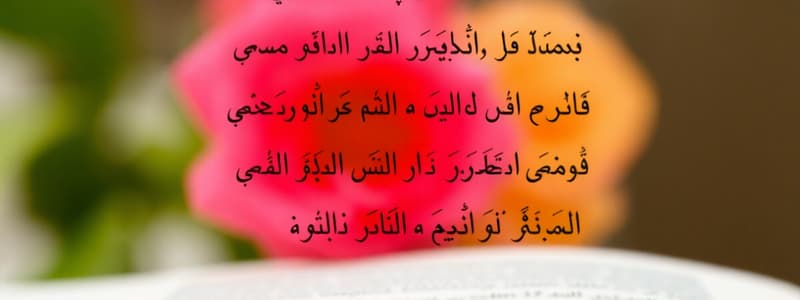Podcast
Questions and Answers
The case endings -u, -a, and -i are always pronounced at the end of prose sentences.
The case endings -u, -a, and -i are always pronounced at the end of prose sentences.
False (B)
At the end of a line in Arabic poetry, it is common for a short -i to rhyme with a long vowel.
At the end of a line in Arabic poetry, it is common for a short -i to rhyme with a long vowel.
True (A)
The indefinite case endings -un, -an, and -in maintain their final -n at the end of a line in poetry.
The indefinite case endings -un, -an, and -in maintain their final -n at the end of a line in poetry.
False (B)
The pronoun anā can never be scanned as ana in Arabic poetry.
The pronoun anā can never be scanned as ana in Arabic poetry.
In Arabic poetry, it is common for the two halves of a bayt to be completely independent with no connection between them.
In Arabic poetry, it is common for the two halves of a bayt to be completely independent with no connection between them.
Al-Khalīl ibn Aḥmad al-Farāhīdī identified 16 types of poetic meter.
Al-Khalīl ibn Aḥmad al-Farāhīdī identified 16 types of poetic meter.
The majority of early classical Arabic poetry is composed using six different meters.
The majority of early classical Arabic poetry is composed using six different meters.
The term 'watid' in Arabic prosody refers to a long syllable.
The term 'watid' in Arabic prosody refers to a long syllable.
Rhyme is not a significant feature in classical Arabic poetry.
Rhyme is not a significant feature in classical Arabic poetry.
Western prosodists analyze poetic meters predominantly by the use of vowelled letters.
Western prosodists analyze poetic meters predominantly by the use of vowelled letters.
The mnemonic words called tafāʿīl represent the feet of an Arabic poem.
The mnemonic words called tafāʿīl represent the feet of an Arabic poem.
The meter 'madīd' is one of the most frequently observed in Arabic poetry.
The meter 'madīd' is one of the most frequently observed in Arabic poetry.
Couplets dominate the structural composition of traditional Arabic poetry.
Couplets dominate the structural composition of traditional Arabic poetry.
Flashcards
ʾiʿrāb
ʾiʿrāb
In spoken Arabic, these endings are often omitted at the end of sentences. However, in poetry, they are typically pronounced even at the end of a sentence.
Vowel Length at Line End
Vowel Length at Line End
At the end of a line in Arabic poetry, any vowel is considered long, even short vowels like -i.
Indefinite Case Ending -n Dropping
Indefinite Case Ending -n Dropping
The -n at the end of indefinite case endings (-un, -an, -in) is dropped when those endings occur at the end of a poetry line.
Long Vowel Pronunciation of -hu
Long Vowel Pronunciation of -hu
Signup and view all the flashcards
Rhyming Long ī and ū
Rhyming Long ī and ū
Signup and view all the flashcards
ʿArūḍ (Arabic prosody)
ʿArūḍ (Arabic prosody)
Signup and view all the flashcards
Poetic Meter
Poetic Meter
Signup and view all the flashcards
Watid (peg)
Watid (peg)
Signup and view all the flashcards
Sabab (cord)
Sabab (cord)
Signup and view all the flashcards
Foot (rukn)
Foot (rukn)
Signup and view all the flashcards
Tafāʿīl
Tafāʿīl
Signup and view all the flashcards
Buḥūr (meters)
Buḥūr (meters)
Signup and view all the flashcards
European method
European method
Signup and view all the flashcards
Study Notes
Arabic Poetic Meters (ʿArūḍ)
- ʿArūḍ (or ʿilm al-ʿarūḍ) is the study of poetic meters in Arabic poetry.
- It determines if a poem's meter is correct (sound) or flawed.
- Al-Khalīl ibn Aḥmad al-Farāhīdī, an early Arab lexicographer and philologist, established the laws of ʿarūḍ.
- His book, Al-ʿArḍ, described 15 meters; a 16th meter, the mustadārik, was later described by Al-Akhfash al-Akbar.
- Arab prosodists analyze poetry using vowel/consonant combinations, called watid (peg) or sabab (cord). These form larger units for poetic feet (rukn).
- Western prosody analyzes meters by syllable length (long – , short u), which can be optional (anceps x). Certain meters can also have long or short pairing options (biceps).
- 85-90% of classical Arabic poetry uses four meters: ṭawīl (most common), kāmil, wāfir, and basīṭ.
- Rhyme is crucial in classical Arabic poetry, often with identical rhyme in each couplet.
- Meters are represented using mnemonic words called tafāʿīl, usually eight (4+4 or 3+3).
- Arabic meters are categorized as buḥūr.
- Specific European scansion symbols are used to show long, short and anceps syllables (−, u, x).
- The meters in circles 1 and 2 (excluding madīd) are the most frequent. Less common meters marked by * are largely theoretical.
Minor Prosodic Rules
- Case endings (-u, -a, -i) are frequently pronounced in poetry, even at sentence ends—they're commonly omitted in prose.
- Vowels at the end of a line are considered long. A short i can rhyme with a long i. The fatḥa (a) at the end of a line is written like a long vowel (alif).
- The n in certain suffixes (-un, -an, -in) is dropped at end-of-line, changing to ū, ā, ī. This rule does not apply at the end of the first hemistich (half-line).
- "His" (-hu) is often scanned with a long vowel (-hū). "I" (anā) can be scanned as ana.
- A long ī can occasionally rhyme with a long ū (e.g., al-nīlu to maqbūlu).
- Lines in a bayt (couplet) can sometimes run together without a break.
Studying That Suits You
Use AI to generate personalized quizzes and flashcards to suit your learning preferences.




